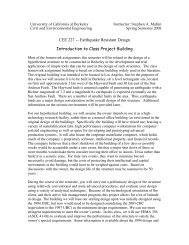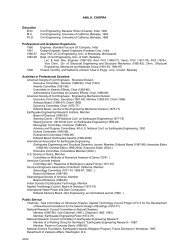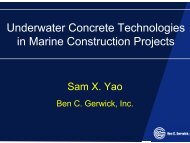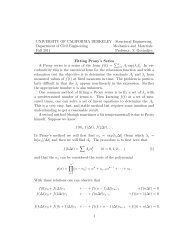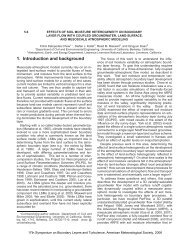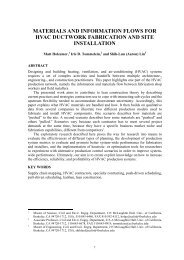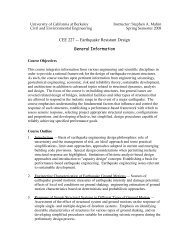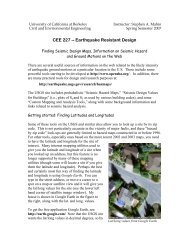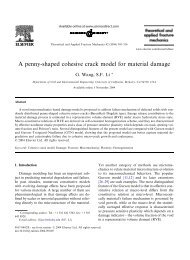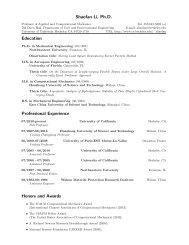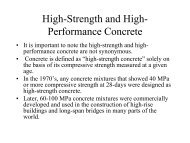CE 241 Advanced Concrete Technology - Civil and Environmental ...
CE 241 Advanced Concrete Technology - Civil and Environmental ...
CE 241 Advanced Concrete Technology - Civil and Environmental ...
You also want an ePaper? Increase the reach of your titles
YUMPU automatically turns print PDFs into web optimized ePapers that Google loves.
<strong>CE</strong> <strong>241</strong><br />
<strong>Advanced</strong> <strong>Concrete</strong><br />
<strong>Technology</strong>
<strong>CE</strong> <strong>241</strong><br />
<strong>Advanced</strong> <strong>Concrete</strong> <strong>Technology</strong><br />
Instructor: Paulo J.M. Monteiro<br />
725 Davis Hall<br />
Office hours: Monday 1-2 am, Tu Th 10-11 pm at 725 Davis Hall<br />
Email: monteiro@ce.berkeley.edu<br />
Grade: 10% HW + 20 % paper + 5% Presentation + 20% Midterm + 45% Final
Why a concrete technology<br />
course?<br />
Paradigm change: More money is<br />
being spent in repairing structures<br />
than in new structures.<br />
t<br />
50% of 500,000 bridges in distress<br />
~ 200 billion to repair<br />
204 dams with AAR
Need for materials<br />
New materials that you should<br />
specify: green concrete, type of<br />
cement, recycled aggregates, high-<br />
strength concrete, low-heat<br />
generation concrete
New criteria<br />
Low-shrinkage<br />
Crack Free<br />
Maximum temperature rise<br />
Architectural concrete<br />
<strong>Environmental</strong> Impact
TWO MAJOR CHALLENGES<br />
Challenge I: <strong>Environmental</strong> Impact<br />
World dem<strong>and</strong>/year<br />
•11.55 billion ton of concrete<br />
•1.5 billion ton of cement<br />
•1 billion ton of water<br />
•99 billion ton of aggregate
Consequences (1)<br />
1.5 billion ton of cement Problem!<br />
Generates 1.5 billion<br />
ton of CO 2<br />
Responsible for 5-7%<br />
CO 2 production in<br />
the world
Business as usual is<br />
not an option!
Consequences (2)<br />
1 billion ton of water<br />
110,000 times the amount of water in<br />
the SF Bay
Consequences (3)<br />
9 billion ton/y of aggregate<br />
Depletion of<br />
natural<br />
resources
Challenges<br />
Challenge II: Long-term durability<br />
<strong>Civil</strong> Infrastructure quickly<br />
deteriorating<br />
March 17,<br />
2008,<br />
I-95 in<br />
Philadelphia
Major deterioration<br />
Corrosion of reinforced concrete<br />
Sulfate attack<br />
Alkali silica reaction<br />
Hot <strong>and</strong> cold weather
Consequences<br />
Of the 597,340 bridges in this<br />
country, 73,784, 784 or about<br />
12.4 percent, are structurally<br />
deficient.
Examples<br />
Itaipu Dam<br />
Nervi Structures<br />
Petronas Tower
Itaipu Dam
To reduce the amount<br />
of concrete in the dam,<br />
the center of the block<br />
is hollow
The spillway, with a<br />
length of 483 m, was<br />
designed for a<br />
maximum discharge<br />
capacity of 62,220<br />
m3/s.
Rome Sports Palace in<br />
Rome<br />
Nervi was a pioneer of “ferrocemento”<br />
or reinforced<br />
mortar, where thin metallic<br />
meshes are embedded in a<br />
mortar to form structural<br />
elements with high ductility<br />
<strong>and</strong> crack-resistance
High Strength <strong>Concrete</strong>
Jan 1994<br />
(photograph courtesy from Leornardo Garzon)
April 1994<br />
(photograph courtesy from Leornardo Garzon)
August 1994<br />
(photograph courtesy from Leornardo Garzon)
September 1994
October 1994
November 1994<br />
(photograph courtesy from Leornardo Garzon)
December 1994<br />
(photograph courtesy from Leornardo Garzon)
February<br />
1995<br />
(photograph courtesy from Leornardo Garzon)
May<br />
1995<br />
(photograph courtesy from Leornardo Garzon)
September<br />
1995<br />
(photograph courtesy from Leornardo Garzon)
February<br />
1996<br />
(photograph courtesy from Leornardo Garzon)
Introduction<br />
A semester in one hour -- relax <strong>and</strong><br />
enjoy…<br />
Pre-requisites: none (the course will<br />
be self-contained)<br />
Textbook: Mehta & Monteiro (hid (third<br />
edition)
Structure <strong>and</strong> properties<br />
of hydrated cement paste<br />
Objectives:<br />
Learn how the<br />
microstructure controls the<br />
properties of concrete.<br />
Identify the main crystals<br />
present in concrete
Transition zone<br />
in concrete<br />
Objectives:<br />
Reinforce the concept that<br />
concrete is not a<br />
homogeneous material.<br />
Show that the zone<br />
between the aggregate <strong>and</strong><br />
the cement paste is the<br />
“weak link” of concrete<br />
affecting many of its<br />
properties.
Factors influencing the<br />
strength<br />
Objectives:<br />
Review the main parameters controlling the strength<br />
development of concrete structures.
<strong>Concrete</strong> strength under<br />
various stress states
Elastic behavior
Creep <strong>and</strong> drying<br />
shrinkage<br />
Objectives:<br />
To study the mechanisms<br />
of creep, modeling, <strong>and</strong><br />
structural t consequences.<br />
Show that creep <strong>and</strong><br />
shrinkage have the same<br />
mechanism.
Thermal stresses<br />
Objectives:<br />
Analysis <strong>and</strong> control of thermal stresses due to the<br />
hydration of cement.<br />
Applications to dams, off-shore platforms, cathedrals, etc.
Permeability <strong>and</strong><br />
durability
Durability to frost action <strong>and</strong> fire<br />
Objectives:<br />
Describe the mechanism of deterioration caused by ice formation<br />
in concrete.
Deterioration of concrete<br />
by chemical attacks<br />
Objectives:<br />
Describe the damage mechanisms<br />
caused by sulfate attack <strong>and</strong> alkali-<br />
silica reaction.
Deterioration from electrochemical<br />
phenomena
<strong>Concrete</strong> structures in<br />
marine environment
<strong>Concrete</strong> aggregates<br />
Objectives:<br />
Discuss the importance of<br />
aggregates in concrete technology.
Hydraulic cements
Chemical admixtures<br />
Objectives:<br />
Discuss the importance of chemical admixtures for the<br />
manufacture of advanced concrete
Mineral admixtures<br />
Objectives:<br />
Discuss the advantages of using<br />
mineral admixtures both to<br />
improve the properties of concrete<br />
<strong>and</strong> to reduce the pollution in the<br />
world.
Lightweight <strong>and</strong><br />
heavyweight ht concrete
High-strength <strong>and</strong> high-<br />
performance concrete<br />
Objectives:<br />
To introduce mix proportions to<br />
obtain high-strength concrete <strong>and</strong><br />
to discuss construction ti methods<br />
using HSC<br />
Green <strong>Concrete</strong>
Shrinkage-compensating<br />
concrete
Fiber-reinforced reinforced concrete
Mass concrete<br />
Objectives:<br />
Techniques to minimize the thermal<br />
stresses in concrete.
Polymers in concrete<br />
Objectives:<br />
To present new research using<br />
polymers in concrete to improve<br />
various properties.
Fracture Mechanics
Non-destructive Methods



